Page 24 of 24
Re: William
Posted: Wed Sep 27, 2017 9:34 pm
by David M
You dedicated your precious time wisely, William, by the looks of things.
Wonderful sequence of rare butterflies, with behaviour rarely seen by we relatively bereft UK-dwellers.
Re: William
Posted: Wed Sep 27, 2017 10:52 pm
by essexbuzzard
Some very evocative pictures there, William, and it seems you put your grant to good use. Anything that can be done to help the Large Blues, an amazingly complex group, can only be good.
Re: William
Posted: Wed May 16, 2018 3:26 pm
by William
Thanks a lot for the kind comments guys, and sorry it's taken so long to respond (and I've been generally quiet on UKB), life has gotten so busy lately that I haven't had much time, but still really enjoy reading everyone's posts!
I thought I'd try and catch up on sharing a few more random bits and bobs from (and since) Hungary!
More Hungarian Stuff
One of the primary motivations for going to Hungary, alongside the Large Blues, was the Large Copper. Given its UK status, it's always been a dream insect steeped in myth and legend for me, and I swore I'd seek it out at my first available opportunity. Give or take 8 years of dreaming and summers curtailed by exams, and I finally had my chance in the Ferto Hansag National park, and am pleased to report that it was very much worth the wait!

- Large Copper - Male

- Large Copper - Male

- Large Copper - Male
My general experience was that Large Coppers are sort of similar to Small Coppers in the way they occur (rather than, say Purple - Edged Coppers), flying in low densities over large areas, and appearing rather randomly in ones and twos in habitat that was far from what you might think of as 'typical'. In my imagination, I thought I'd be encountering them tearing over reeds and marshes in vast acreages of pristine habitat, but the reality was more prosaic (and perhaps heartening). The best site I found for them was along a little river on the edge of a small town, a railway (complete with underpass and graffiti) passed through it, and the locals used it for dirt biking and running, it was a tiny, random, strip of habitat, where I encountered a (by Large Copper standards) monumental 15 individuals. This seems to be very much the norm in Hungary, where Large Coppers are fairly common butterflies found over large areas in a relatively intact, low intensity landscape, rather than restricted to small areas of high quality habitat in an otherwise hostile agricultural matrix as is the case Western Europe.

Perhaps the best way to sum this up came in my first half hour in Hungary after getting off the plane and meeting the National Park staff. I tentatively asked them if they thought I'd be able to see Large Copper during my stay, and was met with a laugh, and the question: 'why are you so interested in them', in other words, in the Ferto Hansag at least, the Large Copper populations are in rude health!
During the week, most of my time was spent chasing Large Blues (with the occasional Large Copper encounter), giving me the chance to head out at the weekends on my borrowed Bicycle and get to know the Large Coppers. One particularly memorable weekend was spent watching them go to roost in the evening, before getting up at 3:00 at that night to watch them get up again as the sun rose, serenaded by Turtle Doves and Golden Orioles, it really doesn't get much better than that.
Roosting tended to occur in loose groups along the river bank (sometimes a couple together, at most three), with the butterflies generally positioning themselves about two thirds of the way up the vegetation seemingly always choosing patches of sedges.

- Large Copper - Male

- Large Copper - Male
Once I got to know the butterflies, I started to search for their immature stages, the Water Docks on which they feed are actually quite uncommon along the Dykes - I never found any at the site above for example, which may explain the wide-ranging behaviour of females (which I tended to encounter quite randomly often far from water), but found lots on a patch of very dry waste ground, with the most favoured plants small ones with the smallest leaves.
One of the high points of the Large Copper experience came right at the end, with my final Large Copper of the trip, which looked somewhat darker in flight, when it alighted, I soon realised why....a stunning ab. radiata, a final gift from a butterfly that just kept on giving.
Re: William
Posted: Wed May 16, 2018 5:45 pm
by Pauline
Stunning shots of those Large Copper William - artistic images, butterfly behaviour and an ab thrown in for good measure. What's not to like - couldn't ask for much more really

Re: William
Posted: Wed May 16, 2018 8:26 pm
by Katrina
Wonderful report and photos. Scores 11 out of 10

Re: William
Posted: Wed May 16, 2018 8:32 pm
by millerd
All I can say is



Lovely photos of a stunning butterfly.
Dave
Re: William
Posted: Wed May 16, 2018 8:39 pm
by bugboy
You may not post that often but when you do post.... WOW!

Re: William
Posted: Thu May 17, 2018 12:38 pm
by Wurzel
I didn't know what to type the sheer awesomeness of the images rendered me lost for words (something I'm not used to

)




Have a goodun
Wurzel
Re: William
Posted: Thu May 17, 2018 10:55 pm
by David M
Fabulous, William. I absolutely love it. You’ve managed to find not only an iconic European butterfly but two of the other three life cycle stages. First class, as indeed are the images, which make me yearn to spend time in such an environment myself.
Re: William
Posted: Fri May 18, 2018 4:48 am
by trevor
I can recommend the Scarce Copper too, if you look at page 72 of my diary
you'll see what I mean.
Lovely images,
Trevor.
Re: William
Posted: Fri May 18, 2018 7:59 am
by William
Thanks for the kind comments everyone - it was wonderful not only to finally have the chance to see Large Coppers, but get to know them over the course of 6 weeks, they really are stunning insects.
Trevor - I've seen a few Scarce Coppers in the Alps (though yet to find any eggs or larvae), equally fantastic beasts!
Cheers,
Will
Re: William
Posted: Fri May 18, 2018 2:15 pm
by MikeOxon
Congratulations on your studies in Hungary, William. The Large Copper has poignant memories for me, since I recall the re-introduction at Wood Walton Fen in the 1980s, which at one time seemed to be going well and merited a TV documentary. I had acquired a permit and was about to visit when the population crashed and, once again, became extinct. It now seems that this univoltine sub-species batavus is very fragile in the Netherlands as well.
It is good to be reminded that there are still extensive tracts of 'wilderness' in Eastern Europe. One of the advantages of European collaboration is that it raises the possibilities for preservation of these areas, by supplying agricultural needs from other parts of the European Union. Whether such a degree of co-operation can be achieved, however, remains doubtful.
In the UK, matters seem even less hopeful. In my local area, the remarkably wetland of Otmoor, just north of Oxford, is once again under threat from road development, even after major protests in the 1980s led successfully to re-routing of the M40.
Mike
Re: William
Posted: Fri May 18, 2018 6:39 pm
by Maximus
I agree with all the other comments, William, great commentary and jaw-dropping images of a stunning butterfly

Mike
Re: William
Posted: Mon Jun 25, 2018 10:08 pm
by William
Thanks Mike(s)!
Large Coppers retain the same thrill for me too, they seem to embody a lot of what's been lost in the last couple of centuries from the UK (and remains relatively intact in places like Hungary), with an entire habitat disappearing under grade 1 carrot fields. What was particularly interesting about the Large Coppers in Hungary was that they weren't really in 'wilderness' habitats, quite the opposite - along canals and drainage ditches, and on waste ground in very intensively farmed landscapes, which really confounded my expectations.
I've been following the developments with Otmoor too, Mike, as I'm now spending a lot of time in Oxford (and consequently Bernwood and Otmoor!), let's hope history repeats itself (though not at the expense of some of the other excellent sites in the area).
Cheers,
Will
Re: William
Posted: Fri Feb 07, 2020 8:29 pm
by William
Catching Up
Sadly I haven't had as much time as I did to post on UK Butterflies in the last year or so, but as ever I still enjoy reading about everyone else's butterflies, and indeed looking for my own. Despite this, I thought I'd try and resuscitate my diary and do a bit of catching up (with a few highlights from the last couple of years) to tide over this last lean month before the season gets going again.
I thought I'd start with 2018 where the first highlight came in April at the incomparable Bernwood Forest Meadows. There was much wailing and gnashing of teeth on my part (and others) when the M40 compensation area was closed off (just as I moved up to Oxford!), but this is a really fantastic place to look for Black Hairstreaks too, and a really idyllic to boot - some of my favourite days butterflying have been spent looking for the hairstreaks here with singing Cuckoos, distant Curlews and Hobbys overhead, alongside Foresters and droves of the more common grassland butterflies.
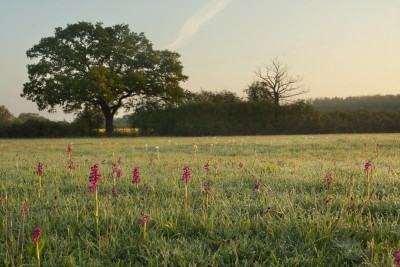
- Bernwood Forest Meadows - April 2018
On this particular morning I found my first Black Hairstreak larva wondering around in the blackthorn on the forest edge - beautifully camouflaged with delicate crimped edges and pink trim, just like the unfolding blackthorn leaves it was feeding on.
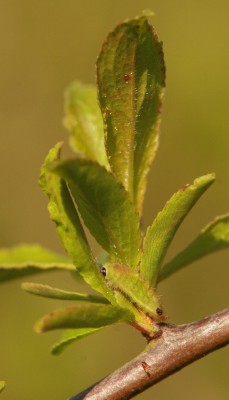
- Black Hairstreak Larva
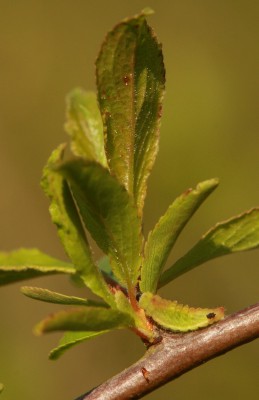
- Black Hairstreak Larva
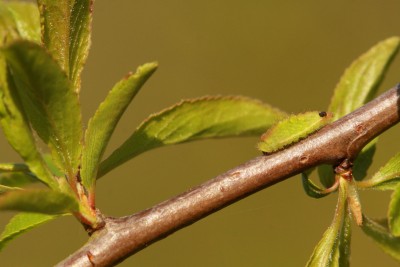
- Black Hairstreak Larva
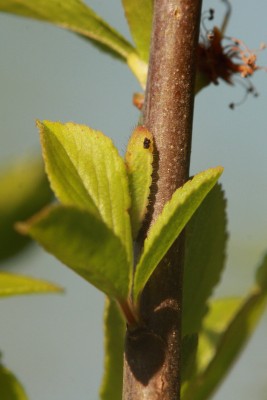
- Black Hairstreak Larva - look at that camouflage!
Spring 2018 was relatively quiet for butterflies otherwise, that is apart from a memorable trip down to Sussex to see Dukes and Pearls with the indomitable Neil. We were blessed with fantastic weather, and it was a real privilege to see both species by the lorry-load on some of Neil's lovingly restored sites. Extra excitement was provided by my first White Admiral larva at Eartham Woods, something I'm still struggling to find in Oxfordshire.
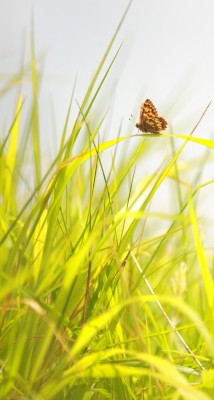
- Duke of Burgundy
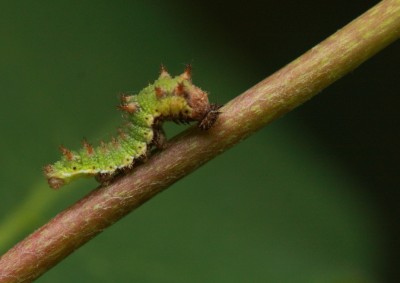
- White Admiral Larva
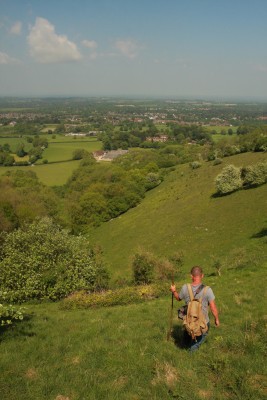
- Neil in Action
As June got going, I was back in Oxford and lucky enough to be well-placed for the Black Hairstreak annus mirabilis - during a happy two days I counted 167 in various different parts of the Bernwood Forest complex, with courting pairs, egg-laying females and tumbles over the tops of the blackthorn thickets galore.
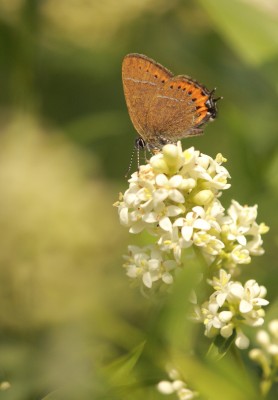
- Black Hairstreak
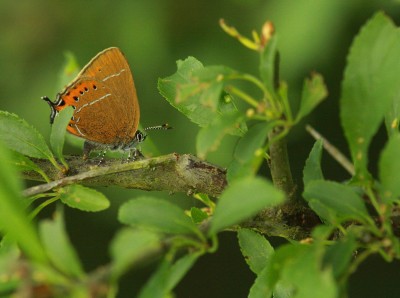
- Black Hairstreak
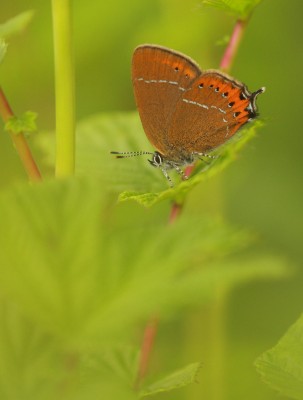
- Black Hairstreak
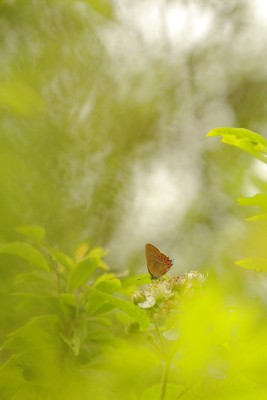
- Black Hairstreak
Amazingly, I didn't see another butterfly-er the whole time I was there, Bernwood can fantastically quiet and wild despite being near a large city in the middle of England, and is surrounded by wonderful countryside, in which Black Hairstreak seems to be quite widespread.
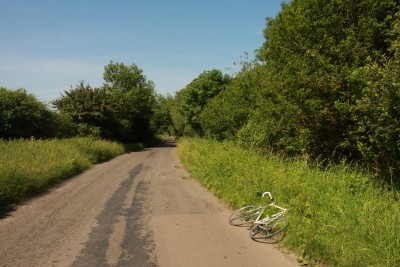
- A quiet lane near Bernwood - Black Hairstreak country (featuring my (t)rusty steed)
Re: William
Posted: Sat Feb 08, 2020 8:30 pm
by Wurzel
Absolutely fantastic images of the lack Hairstreaks - love the dreamy sift focus round the margins as well



Hopefully you'll have a bit more time and we'll a bit more of you on UKB this year

Have a goodun
Wurzel
Re: William
Posted: Mon Feb 10, 2020 7:51 pm
by David M
William wrote: ↑Fri Feb 07, 2020 8:29 pm...I thought I'd try and resuscitate my diary and do a bit of catching up (with a few highlights from the last couple of years) to tide over this last lean month before the season gets going again.
Lovely sequence of images as per usual, William. Please feel free to 'resuscitate' away between now and the first mild, sunny days of spring when butterflies will return.
Re: William
Posted: Tue Feb 11, 2020 3:44 pm
by Matsukaze
Lovely photos of some beautiful places and excellent butterfly sites.
I saw White Admiral just up the path from the car park at Bernwood in June 2017. Technically Buckinghamshire I know, but they are in the woodland complex.